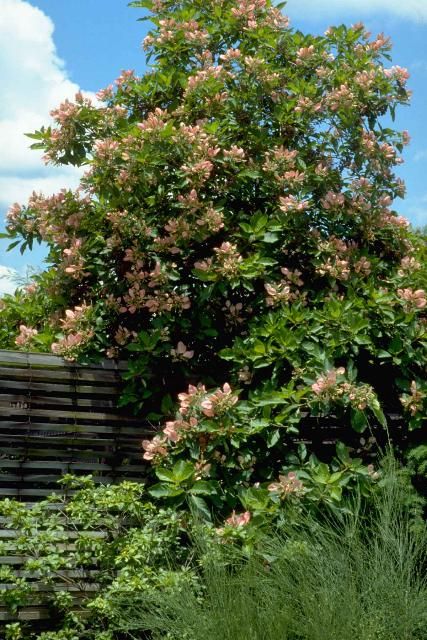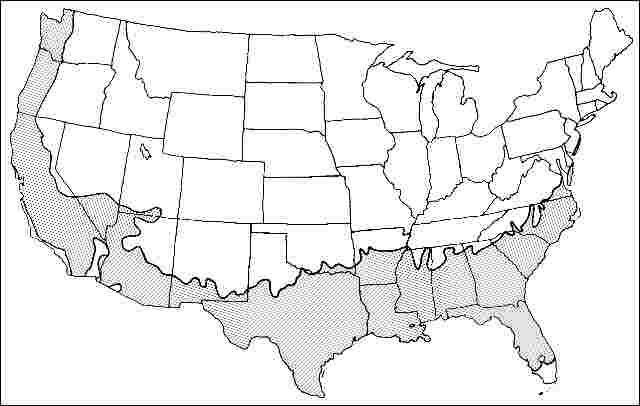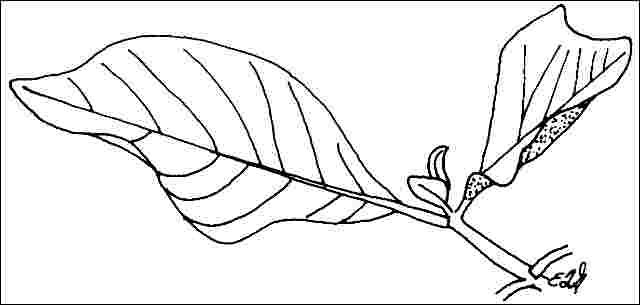Introduction
In earlier days, malaria and other fevers were treated at home with a medicine made from the inner bark of this deciduous, 30-foot-tall, North American native tree, giving it the common name "Fevertree". The tree is also referred to as Pinckneya bractea .The tree is more commonly seen at 15 to 20 feet tall by 15 feet wide as an open-grown landscape tree. The large, dark green leaves, five to eight inches long and three to four inches wide, have a lighter underside and are covered with a light fuzz when young. The clusters of yellowish-green, 2.5-inch-long tubular flowers are made more conspicuous by the cream to bright rose-colored, petal-like sepals, making Fevertree quite spectacular when it is in full bloom in early summer. The brown, spotted, round seed capsules which follow stay on the trees throughout the winter.

Credit: Ed Gilman
General Information
Scientific name: Pinckneya pubens
Pronunciation: PINK-nee-uh PEW-benz
Common name(s): Pinckneya, Fevertree
Family: Rubiaceae
USDA hardiness zones: 7B through 9B (Fig. 2)
Origin: native to North America
Invasive potential: little invasive potential
Uses: specimen; deck or patio; container or planter
Availability: not native to North America

Description
Height: 15 to 20 feet
Spread: 12 to 18 feet
Crown uniformity: irregular
Crown shape: round
Crown density: open
Growth rate: moderate
Texture: coarse
Foliage
Leaf arrangement: opposite/subopposite (Fig. 3)
Leaf type: simple
Leaf margin: entire
Leaf shape: elliptic (oval), oblong
Leaf venation: pinnate, reticulate
Leaf type and persistence: deciduous
Leaf blade length: 4 to 8 inches
Leaf color: green
Fall color: no color change
Fall characteristic: not showy

Flower
Flower color: yellow, pink
Flower characteristics: very showy
Fruit
Fruit shape: round
Fruit length: .5 to 1 inch
Fruit covering: dry or hard
Fruit color: brown
Fruit characteristics: does not attract wildlife; showy; fruit/leaves not a litter problem
Trunk and Branches
Trunk/bark/branches: branches droop; not showy; typically multi-trunked; thorns
Pruning requirement: needed for strong structure
Breakage: resistant
Current year twig color: gray, brown
Current year twig thickness: medium
Wood specific gravity: unknown
Culture
Light requirement: full sun, partial sun or partial shade
Soil tolerances: clay; sand; loam; acidic; extended flooding; well-drained
Drought tolerance: moderate
Aerosol salt tolerance: unknown
Other
Roots: not a problem
Winter interest: no
Outstanding tree: no
Ozone sensitivity: unknown
Verticillium wilt susceptibility: unknown
Pest resistance: free of serious pests and diseases
Use and Management
The unusual, open, coarse habit of growth and showy flowers make this a conversation piece in any yard. Use it as an accent in a sunny shrub border or as a specimen near the patio or deck. This is certainly a tree to consider when planning a yard due to the small size and pest resistance.
Found in its native habitat on poorly drained land or along swamp-margins, Fevertree should only be planted on moist soils or those areas which are flooded with rains periodically throughout the year. Although best flowering appears to be in full sun, trees grown in partial shade will grow but flower poorly. Not for a landscape unless it is occasionally irrigated during dry summers.
Propagation is by seed or division of the many root-suckers.
Pests and Diseases
No pests or diseases are of major concern.